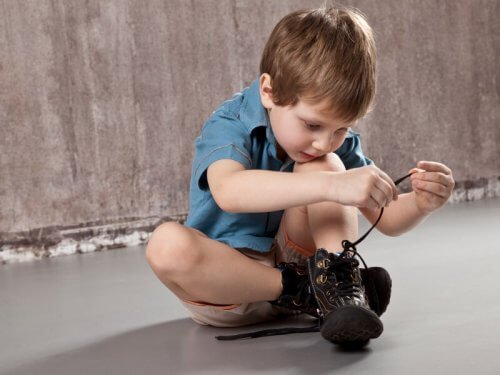Hyperactive Children: Trauma or Childhood Stress?


Written and verified by the psychologist Valeria Sabater
There can be delicate realities behind hyperactive children. However, we sometimes simply medicate those behaviors. As striking as it may seem, we do so without first understanding the factors that drive certain behaviors. Some children suffer from stress, come from broken homes, or have attachment issues.
We’ll begin by pointing out beforehand that this is a very sensitive issue. It’s sensitive for health professionals while complex for families with children diagnosed with ADHD. First of all, there are many psychologists, psychiatrists, and neurologists that believe that attention deficit disorders, with or without hyperactivity, don’t exist.
This behavioral syndrome presents a vast spectrum of manifestations. According to Murphy and Gordon (1998), it tends to affect 2-5% of children. It can manifest before the age of 7. If it’s not properly diagnosed and treated, it’s very likely that these children may suffer from anxiety disorders or even depression as adults.
Since the 19th century, we’ve known about early cases of hyperactive and impulsive children with attention problems. British pediatrician Sir George Frederic Still (1868 – 1941) was the first person to describe this condition. To this day, both clinical psychologists and psychiatrists continue to defend the existence of ADHD.
However, there’s something they emphasize above all else: the importance of a correct diagnosis.

Hyperactive children don’t always have ADHD
There are nervous children who exhibit challenging, violent, and disruptive behavior in school. Likewise, there are also children who are restless and unable to display their full cognitive potential due to classroom conditions that don’t fit their educational needs.
Thus, we have two very different realities that can’t be classified in the same way under the term ADHD. Not all students who are lazy, unruly, disruptive, or tantrum-prone fall under the same category. These children would benefit greatly from a specific curricular adaptation for their behavioral syndrome.
However, other children need other types of help. In some cases, there may be some sort of trauma behind a hyperactive child. For example, there could be abusive, chaotic, or broken family environments. In these instances, curricular adaptations or medication won’t be able to help.
A famous study
Nicole Brown is a child psychiatrist who works at Johns Hopkins Hospital in Baltimore. Her particular study was published by various media outlets for a very specific purpose: to raise awareness of the need for more precise, sensitive, and adequate diagnoses.
At a Pediatric Academic Societies Annual Meeting, Dr. Brown presented the information she had gathered. She reported that many children diagnosed with ADHD weren’t hyperactive. These children were actually hypervigilant and stressed out. In other words, they showed signs of trauma.
In those cases, neither behavioral therapy nor stimulants worked. These were more delicate situations. She discovered that the causes of these children’s hyperactivity were none other than dysfunctional families or traumatic events these children suffered at some point.

The importance of a correct diagnosis
Doctors Marc Ferrer, Oscar Andión, and Natalia Calvo conducted an interesting study. Its purpose was to differentiate symptomatology in adulthood from trauma, borderline personality disorders, and ADHD. We know that trauma causes behaviors similar to hyperactivity. As the child grows and turns into an adult, its effects are much more adverse.
- Therefore, detecting these type of realities at an early age is essential.
- Inattentive, impulsive, and nervous behavior isn’t always a sign of ADHD. This is something teachers, as well as anyone who works with children on a daily basis, should know.
- Sometimes, there’s adversity, family suffering, and childhood stress behind hyperactive children.
- Therefore, good professionals, child psychiatrists, and clinical psychologists know that they should also evaluate a child’s family and the complex environment they live in.

Likewise, we should also point out another important aspect. Parents of children who have been correctly diagnosed with ADHD know that they’re not responsible for this syndrome. However, they have a difficult process ahead of them. With the school’s help, they need to tend to the hyperactive child’s particular needs.
There can be delicate realities behind hyperactive children. However, we sometimes simply medicate those behaviors. As striking as it may seem, we do so without first understanding the factors that drive certain behaviors. Some children suffer from stress, come from broken homes, or have attachment issues.
We’ll begin by pointing out beforehand that this is a very sensitive issue. It’s sensitive for health professionals while complex for families with children diagnosed with ADHD. First of all, there are many psychologists, psychiatrists, and neurologists that believe that attention deficit disorders, with or without hyperactivity, don’t exist.
This behavioral syndrome presents a vast spectrum of manifestations. According to Murphy and Gordon (1998), it tends to affect 2-5% of children. It can manifest before the age of 7. If it’s not properly diagnosed and treated, it’s very likely that these children may suffer from anxiety disorders or even depression as adults.
Since the 19th century, we’ve known about early cases of hyperactive and impulsive children with attention problems. British pediatrician Sir George Frederic Still (1868 – 1941) was the first person to describe this condition. To this day, both clinical psychologists and psychiatrists continue to defend the existence of ADHD.
However, there’s something they emphasize above all else: the importance of a correct diagnosis.

Hyperactive children don’t always have ADHD
There are nervous children who exhibit challenging, violent, and disruptive behavior in school. Likewise, there are also children who are restless and unable to display their full cognitive potential due to classroom conditions that don’t fit their educational needs.
Thus, we have two very different realities that can’t be classified in the same way under the term ADHD. Not all students who are lazy, unruly, disruptive, or tantrum-prone fall under the same category. These children would benefit greatly from a specific curricular adaptation for their behavioral syndrome.
However, other children need other types of help. In some cases, there may be some sort of trauma behind a hyperactive child. For example, there could be abusive, chaotic, or broken family environments. In these instances, curricular adaptations or medication won’t be able to help.
A famous study
Nicole Brown is a child psychiatrist who works at Johns Hopkins Hospital in Baltimore. Her particular study was published by various media outlets for a very specific purpose: to raise awareness of the need for more precise, sensitive, and adequate diagnoses.
At a Pediatric Academic Societies Annual Meeting, Dr. Brown presented the information she had gathered. She reported that many children diagnosed with ADHD weren’t hyperactive. These children were actually hypervigilant and stressed out. In other words, they showed signs of trauma.
In those cases, neither behavioral therapy nor stimulants worked. These were more delicate situations. She discovered that the causes of these children’s hyperactivity were none other than dysfunctional families or traumatic events these children suffered at some point.

The importance of a correct diagnosis
Doctors Marc Ferrer, Oscar Andión, and Natalia Calvo conducted an interesting study. Its purpose was to differentiate symptomatology in adulthood from trauma, borderline personality disorders, and ADHD. We know that trauma causes behaviors similar to hyperactivity. As the child grows and turns into an adult, its effects are much more adverse.
- Therefore, detecting these type of realities at an early age is essential.
- Inattentive, impulsive, and nervous behavior isn’t always a sign of ADHD. This is something teachers, as well as anyone who works with children on a daily basis, should know.
- Sometimes, there’s adversity, family suffering, and childhood stress behind hyperactive children.
- Therefore, good professionals, child psychiatrists, and clinical psychologists know that they should also evaluate a child’s family and the complex environment they live in.

Likewise, we should also point out another important aspect. Parents of children who have been correctly diagnosed with ADHD know that they’re not responsible for this syndrome. However, they have a difficult process ahead of them. With the school’s help, they need to tend to the hyperactive child’s particular needs.
All cited sources were thoroughly reviewed by our team to ensure their quality, reliability, currency, and validity. The bibliography of this article was considered reliable and of academic or scientific accuracy.
- Ferrer, M., Andión, Ó., Calvo, N., Ramos-Quiroga, JA, Prat, M., Corrales, M., y Casas, M. (2017). Diferencias en la asociación entre el historial de trauma infantil y el trastorno límite de la personalidad o el diagnóstico de trastorno por déficit de atención / hiperactividad en la edad adulta. Archivos Europeos de Psiquiatría y Neurociencia Clínica, 267(6), 541–549. https://doi.org/10.1007/s00406-016-0733-2
- Ladnier, RD, y Massanari, AE (2000). Tratar el TDAH como trastorno de hiperactividad por déficit de apego. En TM Levy & TM Levy (Ed) (Eds.), Manual de intervenciones de apego.(pp. 27-65). Prensa Académica. https://doi.org/10.1016/B978-012445860-4/50003-4
This text is provided for informational purposes only and does not replace consultation with a professional. If in doubt, consult your specialist.







